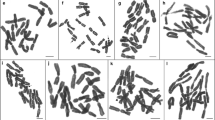Abstract
The karyotypes of five strains ofBotrytis cinerea were analysed by pulsed field gel electrophoresis (PFGE). None of the five chromosome patterns were identical and all five strains contained one or several minichromosomes of variable length. Considering that some of the chromosomal bands represent unresolved doublets, the total genome size of the five strains was estimated to vary between at least 33.9 and 39.7 megabasepairs (Mbp). Hybridization of blots of pulsed field gels with rDNA and ß-tubulin probes revealed that these hybridize with the same chromosomal band. Chromosome-specific probes were isolated hybridizing to chromosomal bands 9 and 11 of strain SAS56. The latter two probes hybridized to only two of the five strains tested. The results are discussed in relation to the genome plasticity and variability of filamentous fungi.
Similar content being viewed by others
References
Chu, G., Vollrath, D. & Davis, R.W., 1986. Separation of large DNA molecules by contour-clamped homogeneous electric fields. Science 254: 1582–1585.
Church, G.M. & Gilbert, W., 1984. Genomic sequencing. Proceedings of the National Academy of Science USA 81: 1991–1995.
De Bary, A., 1866. Morphologie und Physiologie der Pilze, Flechten und Myxomyceten. Engelmann, Leipzig. 316 pp.
Faretra, F. & Antonacci, E., 1987. Production of apothecia ofBotryotinia fuckeliana (de Bary) Whetz. under controlled environmental conditions. Phytopathologia Mediterranea 26: 29–35.
Faretra, F., Antonacci E. & Pollastro, S., 1988a. Improvement of the technique used for obtaining apothecia ofBotryotinia fuckeliana (Botrytis cinerea) under controlled conditions. Annals of Microbiology 38: 29–40.
Faretra F., Antonacci, E. & Pollastro, S., 1988b. Sexual behaviour and mating system ofBotryotinia fuckeliana, teleomorph ofBotrytis cinerea. Journal of General Microbiology 134: 2543–2550.
Grindle, M., 1979. Phenotypic differences between natural and induced variants ofBotrytis cinerea. Journal of General Microbiology 111: 109–120.
Hansen H.N. & Smith, R.E., 1932. The mechanism of variation in imperfect fungi:Botrytis cinerea. Phytopathology 22: 953–964.
Hodgson, C.P. & Fisk, R.Z., 1987. Hybridization probe size control: optimized ‘oligolabelling’. Nucleic Acids Research 15: 6295.
Kistler H.C. & Miao, V.P.W., 1992. New modes of genetic change in filamentous fungi. Annual Review of Phytopathology 30: 131–152.
Lorenz, D.H., 1983. Untersuchungen zur morphologischen Variabilität und Pathogenität vonBotrytis cinerea Pers. undBotryotinia fuckeliana Whetz. Zeitschrift für Pflanzenkrankheiten und Pflanzenschutz 90: 622–633.
McCluskey, K. & Mills, D., 1990. Identification and characterization of chromosome length polymorphisms among strains representing fourteen races ofUstilago hordei. Molecular Plant-Microbe Interactions 3: 366–373.
McDonald, B.A. & Martinez, J.P., 1990. Restriction fragment length polymorphisms inSeptoria tritici occur at high frequency. Current Genetics 17: 133–138.
McDonald, B.A. & Martinez, J.P., 1991. Chromosome length polymorphisms in aSeptoria tritici population. Current Genetics 19: 265–271.
Masel, A.M., Braithwaite, K., Irwin, J.A.G. & Manners, J.M., 1990. Highly variable molecular karyotypes in the plant pathogenColletotrichum gloeosporioides. Current Genetics 18: 81–86.
Masel, A.M., Irwin, J.A.G. & Manners, J.M., 1993. DNA addition or deletion is associated with a major karyotype polymorphism in the fungal phytopathogenColletotrichum gloeosporioides. Molecular and General Genetics 237: 73–80.
Miao, V.P.W., Matthews, D.E. & VanEtten, H.D., 1991a. Identification and chromosomal locations of a family of cytochrome P-450 genes for pisatin detoxification in the fungusNectria haematococca. Molecular and General Genetics 226: 214–223.
Miao, V.P.W., Covert, S.F. & VanEtten, H.D., 1991b. A fungal gene for antibiotic resistance on a dispensable (“B”) chromosome. Science 254: 1773–1776.
Miao, V.P.W. & VanEtten, H.D., 1992. Three genes for metabolism of the phytoalexin maackain in the plant pathogenNectria haematococca: meiotic instability and relationship to a new gene for pisatin demethylase. Applied and Environmental Microbiology 58: 801–808.
Mills, D. & McCluskey, K., 1990. Electrophoretic karyotypes of fungi: the new cytology. Molecular Plant-Microbe Interactions 3: 351–357.
Otten, L., Canaday, J., Gérard, J.-C., Fournier, P., Crouzet, P. & Paulus, F., 1992. Evolution ofAgrobacteria and their Ti plasmids: A review. Molecular Plant-Microbe Interactions 5: 279–287.
Polach, F.J. & Abawi, G.S., 1975. The occurrence and biology ofBotryotinia fuckeliana on beans in New York. Phytopathology 65: 657–660.
Sambrook, J., Fritsch, E.F., Maniatis, T., 1989.Molecular cloning, a laboratory manual. 2nd. edition, Cold Spring Harbor Laboratory Press, USA.
Shirane, N., Masuko, M. & Hayashi, Y., 1988. Nuclear behavior and division in germinating conidia ofBotrytis cinerea. Phytopathology 78: 1627–1630.
Shirane, N., Masuko, M. & Hayashi, Y., 1989. Light microscopic observation of nuclei and mitotic chromosomes ofBotrytis species. Phytopathology 79: 728–730.
Skinner, D.Z., Budde, A.D. & Leong, S.A., 1991. Molecular karyotype analysis of fungi. In: Bennet, J.W. & Lasure L.L. (Eds), More gene manipulations in fungi. Academic Press, San Diego. p. 86–103.
Van der Vlugt-Bergmans, C.J.B., Brandwagt, B.F., Van’t Klooster, J.W., Wagemakers, C.A.M. & Van Kan, J.A.L., 1993. Genetic variation and segregation of DNA polymorphisms inBotrytis cinerea. Mycological Research, 97: 1193–1200.
Vollrath, D. & Davis, R.W., 1987. Resolution of DNA molecules greater than 5 megabases by contour-clamped homogeneous electric fields. Nucleic Acids Research 15: 7865–7876.
Author information
Authors and Affiliations
Rights and permissions
About this article
Cite this article
Van Kan, J.A.L., Goverse, A. & Van Der Vlugt-Bergmans, C.J.B. Electrophoretic karyotype analysis of Botrytis cinerea. Neth. J. Pl. Path. 99 (Suppl 3), 119–128 (1993). https://doi.org/10.1007/BF03041402
Accepted:
Issue Date:
DOI: https://doi.org/10.1007/BF03041402




